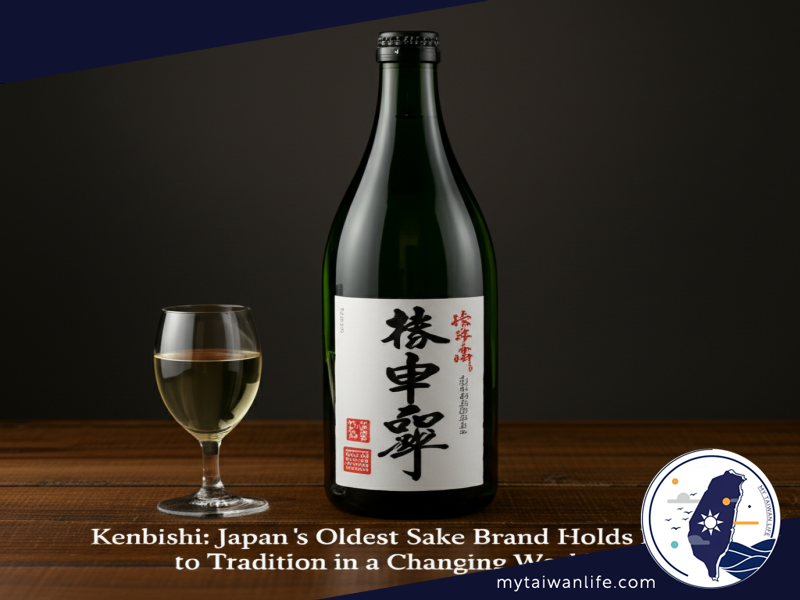Kenbishi: Japan's Oldest Sake Brand Holds Fast to Tradition in a Changing World
Facing a Sake Slump, Kenbishi Brews Resilience by Clinging to Centuries-Old Methods.

In the face of declining domestic consumption, Japan's sake industry grapples with a crisis. Yet, the venerable Kenbishi, the nation's oldest sake brand, remains steadfast in its dedication to time-honored practices, recognizing them as the cornerstone of quality.
At the Kenbishi Sake Brewing Co. facility in Kobe, a bottle of sake graces the staff dining room table, ready to complement the evening meal. In the kitchen, more sake warms in kettles. "It's all-you-can drink at dinner," says Kenbishi President Masataka Shirakashi. He hopes the recent UNESCO recognition of traditional sake-brewing techniques will spark a revival of the beverage among Japanese drinkers.
Tradition is paramount. Brewing exclusively takes place during the winter months. Starting in October, sixty brewers reside onsite for six months, sharing meals in the dining room. By season's end, they will have consumed approximately 1,500 bottles of sake, according to Shirakashi.
However, sake consumption across Japan is declining. Drinking habits are evolving, especially among the younger generation. Data from the National Tax Agency reveals that consumption in 2022 had plummeted to less than a third of its peak in the early 1970s.
"There's no doubt that the sake industry itself is facing a crisis," stated Shirakashi, 48, in February.
The inclusion of traditional sake-brewing knowledge and skills on UNESCO's Intangible Cultural Heritage list in December offered the industry a moment of recognition. Many are now looking to capitalize on the growing international interest in sake.
With exports accounting for only around 2% of Kenbishi's sales, Shirakashi sees the listing as an opportunity for Japanese people to rediscover sake.
In a workshop at Kenbishi's facility, the sound of wood striking wood echoes as a craftsman circles a cedar barrel, using a wooden block and mallet to secure a bamboo hoop around it. The craftsman is making a dakidaru, which will be filled with boiling water and used to control the temperature of the yeast starter mix, allowing heat to dissipate slowly.
While stainless steel and aluminum have become the industry standard, Shirakashi insists that only wood can maintain the temperature crucial to producing Kenbishi's sake. A team of three craftsmen makes approximately 30 dakidaru annually. After each use, the barrel's six taga, or bamboo hoops, need replacing. There are 300 dakidaru in circulation at the brewery.
"Maintenance is a hassle so fewer sake makers are using them," says Shirakashi, who disregards this trend. "It's something you'd usually see in a museum."
The dakidaru is just one of the traditional wooden sake-brewing tools and equipment Shirakashi considers essential to preserving the taste of Kenbishi's sake.
Kenbishi began making its own traditional wooden equipment in 2009 due to dwindling demand. The brewer now supplies equipment and tools for soy sauce and vinegar makers and for the upkeep of temples and shrines.
In December, the brewer announced the addition of komodaru to its traditional equipment lineup. These wooden barrels wrapped in straw are a feature of traditional ceremonies and festivals across Japan.
Kenbishi acquired two local komodaru makers after the COVID-19 pandemic, during which events were canceled, leaving local businesses short of demand and successors.
The manufacture and use of traditional equipment comes at greater financial cost for Kenbishi. However, given its status as Japan's oldest sake brand, Shirakashi feels a significant responsibility to protect it and maintain the taste of Kenbishi sake.
"If we give up on the taste, the brewing methods, and the tools and equipment, Japan will lose all of these things," he said.
Kenbishi claims to have been founded sometime before 1505 in Itami, Hyogo Prefecture. During the Edo period (1603-1868), the brewery's sake was favored by samurai. In 1740, it became an official supplier of sake to the shogun, according to the brewer.
The Shirakashi family is the fifth to have headed Kenbishi. The current president's great-grandfather moved the company to its current location in Kobe's renowned Nada brewing district in 1928.
Despite changes in name and location, the company logo has remained unchanged for over 500 years.
Shirakashi is the fourth-generation head of Kenbishi in his family. The family has a history of navigating the company through crises while upholding the taste of its sake.
During the post-World War II rice shortages, which forced brewers to produce low-quality sanzo-shu -- sake diluted with brewing alcohol or sugar to increase volume -- Shirakashi's grandfather refused to sell it under the Kenbishi name.
Kenbishi was also among the breweries in Nada devastated by the Great Hanshin Earthquake on January 17, 1995, losing all but one of its eight brewing facilities. Upon resuming brewing, it returned to the same equipment and brewing methods.
Shirakashi follows the philosophy of his great-grandfather, who believed that chasing trends would always leave the company behind. Instead, Kenbishi should be like a stopped clock, "always giving the right time twice a day."
"The trends will come back around, so we believe in the sake that our customers have said is delicious," said Shirakashi.
Other Versions
Kenbishi: la marca de sake más antigua de Japón se aferra a la tradición en un mundo cambiante
Kenbishi : la plus ancienne marque de saké du Japon s'accroche à la tradition dans un monde en mutation
Kenbishi: Merek Sake Tertua di Jepang yang Berpegang Teguh pada Tradisi di Tengah Dunia yang Terus Berubah
Kenbishi: il più antico marchio di sake giapponese tiene fede alla tradizione in un mondo in evoluzione
剣菱:日本最古の日本酒ブランド、変化する世界の中で伝統を守り続ける
겐비시: 일본에서 가장 오래된 사케 브랜드, 변화하는 세상 속에서도 전통을 고수하는 겐비시
Kenbishi: Ang Pinakamatandang Tatak ng Sake sa Hapon ay Mahigpit na Kumakapit sa Tradisyon sa Nagbabagong Mundo
Kenbishi: старейшая японская марка саке сохраняет традиции в меняющемся мире
Kenbishi: แบรนด์สาเกที่เก่าแก่ที่สุดของญี่ปุ่นยึดมั่นในประเพณีในโลกที่เปลี่ยนแปลง
Kenbishi: Thương hiệu Sake lâu đời nhất Nhật Bản kiên định với truyền thống trong một thế giới thay đổi

